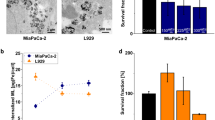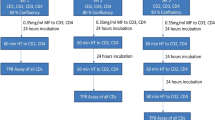Abstract
Mechanism of magnetic fluid hyperthermia (MFH) studied via histological, cellular and in-silico methods. Number of RGB pixels in histopathological or cellar images was calculated to estimate penetration ratio of magnetic nanocomposite (MNC; MoS2/CoFe2O4) into either of tumor tissue or cells. The hydrodynamic diameter and the size distribution of MNC were determined by dynamic light scattering (DLS) and Zeta Sizer, respectively. The molecular dynamic (MD) model of MoS2/CoFe2O4 was studied in a cubic box of water for 6.6 ns to simulate one-time passage of an alternative magnetic field from a side of cubic box. MFH treatment of tumors (f = 150 kHz, H = 31.16 mT) with low concentration of MNC, enhanced penetration of MNCs to the mammary gland tissue. Besides, the membrane permeability of MCF-7 cells was the most in “MNC + MF” condition, which is a validation for increased apoptosis rate expectancy in cancerous cells. The MNC with hydrodynamic diameter of 24.1 ± 0.89 nm produced the greatest “temperature/Etotal” ratio when the lowest MF (2.35 × 103 mT) was applied on the lowest concentration of the MNC (38 mM). Cellular uptake of MNC by the cancerous MCF-7 cells in the presence of MF, considerably boosted compared to the time that no MF was applied. Therefore, application of low-amplitude MF on low concentration of MNC results in targeted apoptosis of cancerous cells, while leaving normal cells intact.



taken from nanoparticles. The top panel shows the DLS results and the bottom panel shows the zeta potential results

Similar content being viewed by others
References
Alavijeh MS, Maghsoudpour A, Khayat M, Rad I, Hatamie S (2020) Distribution of “molybdenum disulfide/cobalt ferrite” nanocomposite in animal model of breast cancer, following injection via differential infusion flow rates. J Pharm Investig 50:583–592
Alavijeh MS, Maghsoudpour A, Khayat M, Rad I, Hatamie S (2021a) Cobalt ferrite decoration of molybdenum disulfide nanosheets; development of a nanocomposite-mediated hyperthermia method. J Mech Sci Technol 35(3):1319–1325
Alavijeh MS, Bani MS, Rad I, Hatamie S, Zomorod MS, Haghpanahi M (2021b) Antibacterial properties of ferrimagnetic and superparamagnetic nanoparticles: a comparative study. J Mech Sci Technol 35(2):815–821
Alinezhad-Bermi S, Kabiri M, Rad I, Irani S, Hanaee-Ahvaz H (2021) Hyperosmolarity benefits cartilage regeneration by enhancing expression of chondrogenic markers and reducing inflammatory markers. IVAN-Animal 57(3):290–299
Farzaneh S, Hosseinzadeh S, Samanipour R, Hatamie S, Ranjbari J, Khojasteh A et al (2021) Fabrication and characterization of cobalt ferrite magnetic hydrogel combined with static magnetic field as a potential bio-composite for bone tissue engineering. J Drug Deliv Sci Technol, 102525
Feng B, Qiu L, Ye C, Chen L, Fu Y, Sun W (2016) Exposure to a 50-Hz magnetic field induced mitochondrial permeability transition through the ROS/GSK-3β signaling pathway. Int J Radiat Biol 92(3):148–155
Hatamie S, Balasi ZM, Ahadian MM, Mortezazadeh T, Shams F, Hosseinzadeh S et al (2021) Hyperthermia of breast cancer tumor using graphene oxide-cobalt ferrite magnetic nanoparticles in mice. J Drug Deliv Sci Technol 65:102680
Hesari R, Keshvarinia M, Kabiri M, Rad I, Parivar K, Hoseinpoor H et al (2020a) Combination of low intensity electromagnetic field with chondrogenic agent induces chondrogenesis in mesenchymal stem cells with minimal hypertrophic side effects. Electromagn Biol Med 39(2):154–165
Hesari R, Keshvarinia M, Kabiri M, Rad I, Parivar K, Hoseinpoor H et al (2020b) Comparative impact of platelet rich plasma and transforming growth factor-β on chondrogenic differentiation of human adipose derived stem cells. BioImpacts 10(1):37
Jahangirian H, Kalantari K, Izadiyan Z, Rafiee-Moghaddam R, Shameli K, Webster TJ (2019) A review of small molecules and drug delivery applications using gold and iron nanoparticles. Int J Nanomed 14:1633
Karami S, Kouhkan F, Rad I, Tavakolpoor Saleh N, Shokri G, Fallah P et al (2021) The MiR-561 suppresses glioblastoma cell proliferation through C-myc regulation. Middle East J Cancer 12(3):321–331
Kaur P, Aliru ML, Chadha AS, Asea A, Krishnan S (2016) Hyperthermia using nanoparticles–promises and pitfalls. Int J Hyperth 32(1):76–88
Kazem-Arki M, Kabiri M, Rad I, Roodbari NH, Hosseinpoor H, Mirzaei S et al (2018) Enhancement of osteogenic differentiation of adipose-derived stem cells by PRP modified nanofibrous scaffold. Cytotechnology 70(6):1487–1498
Khodayari K, Alipour M, Rad I, Ramshini H, Abdolmaleki P (2021) Inhibition potential evaluation of two synthetic bis-indole compounds on amyloid fibrillation. A molecular simulation study. J Biomol Struct Dyn. https://doi.org/10.1080/07391102.2020.1852962
Kouhzaei S, Rad I, Khodayari K, Mobasheri H (2013) The neuroprotective ability of polyethylene glycol is affected by temperature in ex vivo spinal cord injury model. J Membr Biol 246(8):613–619
Li Q, Xuan Y, Li B (2007) Simulation and control scheme of microstructure in magnetic fluids. Sci China Ser E 50(3):371–379
Liu T-Y, Hu S-H, Liu T-Y, Liu D-M, Chen S-Y (2006) Magnetic-sensitive behavior of intelligent ferrogels for controlled release of drug. Langmuir 22(14):5974–5978
Lu G, Gao P (2010) Chapter 3—Emulsions and microemulsions for topical and transdermal drug delivery. In: Kulkarni A, Vitthal S (eds) Handbook of non-invasive drug delivery systems. William Andrew Publishing, Boston
Moosavi MS, Monajjemi M, Zare K (2017) A nano catalyst of Cofe2o4@ B18N18 as a novel material. Orient J Chem 33(4):1648
Moser F, Hildenbrand G, Müller P, Al Saroori A, Biswas A, Bach M et al (2016) Cellular uptake of gold nanoparticles and their behavior as labels for localization microscopy. Biophys J 110(4):947–953
Nazari H, Heirani-Tabasi A, Hajiabbas M, Salimi Bani M, Nazari M, Pirhajati Mahabadi V et al (2020a) Incorporation of SPION-casein core-shells into silk-fibroin nanofibers for cardiac tissue engineering. J Cell Biochem 121(4):2981–2993
Nazari H, Kehtari M, Rad I, Ashtari B, Joghataei MT (2020) Electrical stimulation induces differentiation of human cardiosphere-derived cells (hCDCs) to committed cardiomyocyte. J Cell Biochem 121(4):2981–2993
Rad I, Honardoost M (2020) Structural modification in hepatitis C virus envelope protein; potential viral strategy against interferon therapy. Int J Pept Res Ther 26(1):171–179
Rad I, Jalali K (2018) Electronic transmission of antibacterial property into water at extremely low frequency range: a preliminary study. J Altern Complement Med 24(5):431–438
Rad I, Pollack GH (2018) Cooling of pure water at room temperature by weak electric currents. J Phys Chem B 122(31):7711–7717
Rad I, Khodayari K, Kouhzaei S, Mobasheri H (2013) Compound action potential of isolated spinal cord: a biophysical analysis to address activity of individual fibers following contusion injury. J Sci Islam Repub 24(2):113–127
Rad I, Kouhzaei S, Mobasheri H, Saberi H (2014) Novel aspects of spinal cord evoked potentials (SCEPs) in the evaluation of dorso-ventral and lateral mechanical impacts on the spinal cord. J Neural Eng 12(1):16004
Rad I, Khodayari K, Hadi Alijanvand S, Mobasheri H (2015) Interaction of polyethylene glycol (PEG) with the membrane-binding domains following spinal cord injury (SCI): introduction of a mechanism for SCI repair. J Drug Target 23(1):79–88
Rahjerdi AK, Amani J, Rad I, Jafari M, Salmanian AH (2016) Designing and structure evaluation of multi-epitope vaccine against ETEC and EHEC, an in silico approach. Protein Pept Lett 23(1):33–42
Schneider CA, Rasband WS, Eliceiri KW (2012) NIH Image to ImageJ: 25 years of image analysis. Nat Methods 9(7):671–675
Shojaee P, Niroomand-Oscuii H, Sefidgar M, Alinezhad L (2020) Effect of nanoparticle size, magnetic intensity, and tumor distance on the distribution of the magnetic nanoparticles in a heterogeneous tumor microenvironment. J Magn Magn Mater 498:166089
Soltanmoradi S, Kouhkan F, Rad I (2021) Neuroinflammatory state of multiple sclerosis and strategies for biotherapeutics development. Int J Med Lab 8(3):168–179
Suleman M, Riaz S (2020a) 3D in silico study of magnetic fluid hyperthermia of breast tumor using Fe3O4 magnetic nanoparticles. J Thermal Biol 91:102635
Suleman M, Riaz S (2020b) In silico study of enhanced permeation and retention effect and hyperthermia of porous tumor. Med Eng Phys 2020(86):128–137
Tamaddon M, Shokri G, Rad SMAH, Rad I, Razavi ÀE, Kouhkan F (2020) Involved microRNAs in alternative polyadenylation intervene in breast cancer via regulation of cleavage factor “CFIm25.” Sci Rep 10(1):1–11
Valente KP, Suleman A, Brolo AG (2020) Exploring diffusion and cellular uptake: charged gold nanoparticles in an in vitro breast cancer model. ACS Appl Bio Mater 3(10):6992–7002
Wang G, Zhou F, Lu Z, Ma Y, Li X, Tong Y et al (2019) Controlled synthesis of CoFe2O4/MoS2 nanocomposites with excellent sedimentation stability for magnetorheological fluid. J Ind Eng Chem 70:439–446
Funding
Funding information is not applicable/No funding was received.
Author information
Authors and Affiliations
Corresponding author
Ethics declarations
Conflict of interest
Authors have no conflict of interest.
Additional information
Publisher's Note
Springer Nature remains neutral with regard to jurisdictional claims in published maps and institutional affiliations.
Rights and permissions
About this article
Cite this article
Shahsavari Alavijeh, M., Rad, I. & Hatamie, S. Magnetic nanocomposite’s mechanism of action during the hyperthermia treatment of the breast cancer. Appl Nanosci 11, 2739–2746 (2021). https://doi.org/10.1007/s13204-021-02203-w
Received:
Accepted:
Published:
Issue Date:
DOI: https://doi.org/10.1007/s13204-021-02203-w




